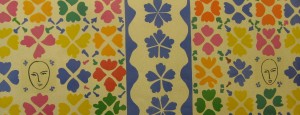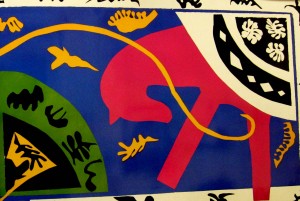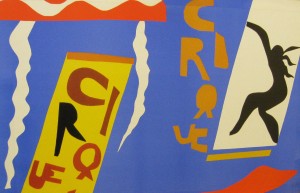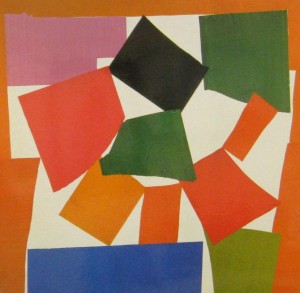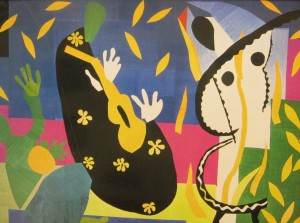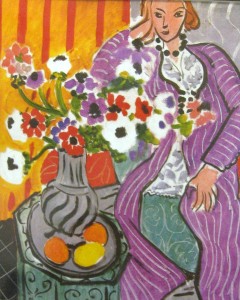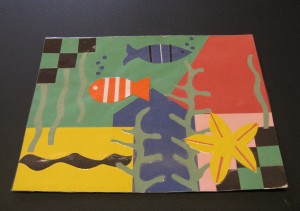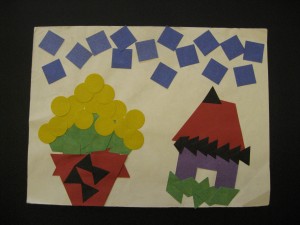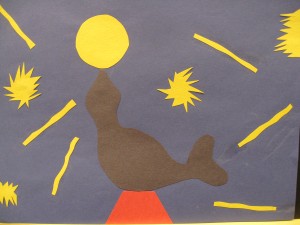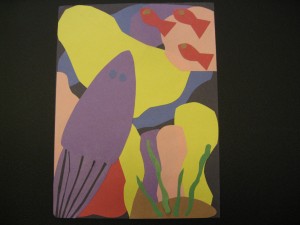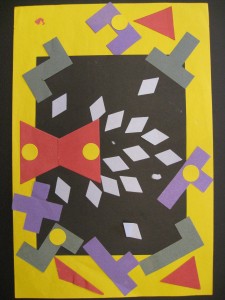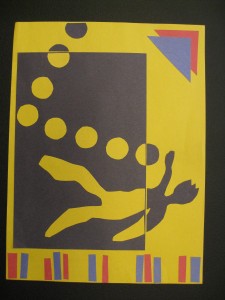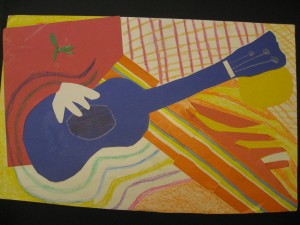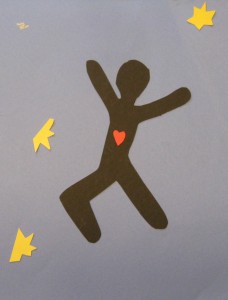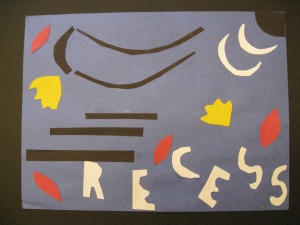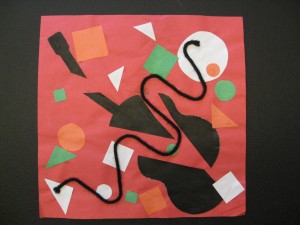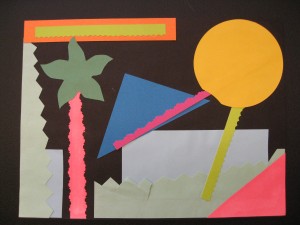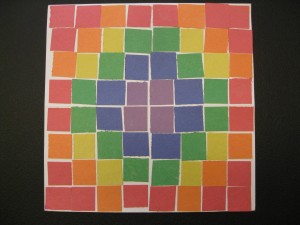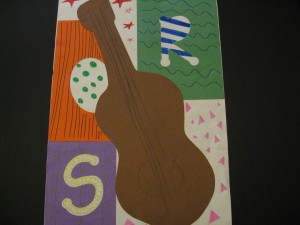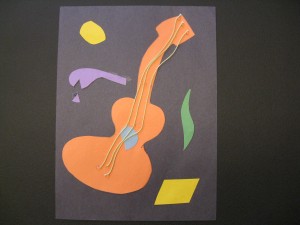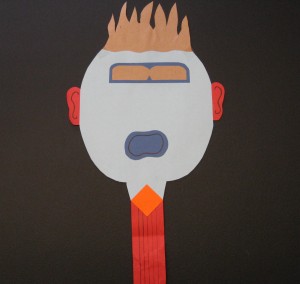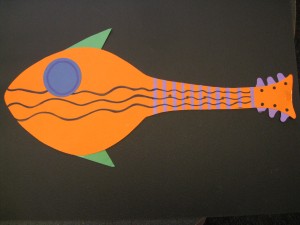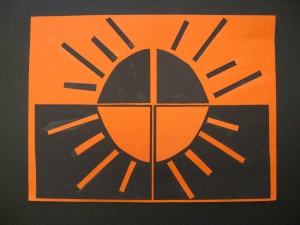1. Madame Matisse (The Green Stripe)
2. Large Decoration with Masks (from “JAZZ”)
3. The Horse, the Rider and the Clown (from “JAZZ”)
Packet Extras:
Icarus
Purple Dress and Anemones
Goldfish
Sample Projects:
Define and compare EXPRESSIONISM and REALISM. Define ABSTRACT and FAUVE STYLE. Compare Matisse’s FAUVE STYLE with a realistic Portrait by another artist. How are they alike/different?
COLOR is an important emphasis in Matisse’s work. This was not just during his Fauve (Wild Beast) period, but continued throughout the rest of his life. Madame Matisse, also called The Green Stripe, is an example of Matisse’s Fauve Style. Although Matisse only painted this way for a few years, his name is the one that comes to mind whenever “Fauve” is mentioned. Compare the artist’s later works to these pictures. How are they alike/different? Which are more realistic and which are more abstract? Of the entire group of pictures, which is the most/least abstract?
SHAPE is a major element used in the cut-paper collages. Matisse sculpted with scissors to create shapes for his pictures from painted colored paper. Ask kids to find, also to define, geometric, organic, and freeform SHAPE. This is a great packet for grades 2-3, for learning or reviewing the combination of GEOMETRIC and ORGANIC SHAPES to create FREEFORM SHAPES (EALR).
Be sure to discuss the NEGATIVE SPACE surrounding the bright and colorful SHAPES, with grades 3-5. Did Matisse mostly use white or very bright COLOR in the negative space for most of his pictures? Does the brilliant color and varieties of PATTERN make it harder to identify the NEGATIVE SPACE? Which SHAPES are POSITIVE/NEGATIVE?
All three types of BALANCE are represented in this packet. The Snail is an example of RADIAL BALANCE—the design radiates (moves out) from the center. SYMMETRICAL BALANCE is found in Large Decoration with Masks—the same on each side of an imaginary centerline. Symmetrical Balance is the balance of the human face, which has an eye, ear or nostril on each side of center. The other five pictures have the most common type of balance found in art, ASYMMETRICAL. This type of balance has different sizes and arrangements of shapes on each side to “balance” a similar “visual weight” evenly on each side.
Additional facts and information on this artist can be found in Packet 6. Minoan Art of Crete, of this same Rotation, where Matisse’s artwork, Icarus (from JAZZ), is found.
Make sure ALL 7 pictures have been returned to the Packet Carrier after your Presentation is finished.
DEFINITIONS
ABSTRACT: Not the way something really looks. A style of art in which lines, shapes, colors, patterns, and textures are simplified or exaggerated. Geometric shapes and a lack of detail are often features of abstract art. A style that uses shape, design, texture and/or color to depict an object in a way that may not look real but that emphasizes moods or feelings. Often uses bold bright colors.
FAUVES: (fohvz) a group of French artists who painted in a style that emphasized intense color and rapid, vigorous brushstrokes. Fauvism thrived from about 1903 to 1907. Matisse led the informal movement. The Fauves tried to express the vividness and excitement of nature. The bright colors, bold patterns, and rough brushwork of several artists of the 1880’s and 1890’s influenced the group. The influential artists who inspired the Fauves included Paul Cézanne, Paul Gauguin, Georges Seurat and Vincent van Gogh. The word Fauves means “wild beasts” in French. An art critic gave the painters this name because of the unusual boldness of their style.
GOUACHE: A type of thick watercolor, prepared with an added gum, which makes it opaque, or in other words, NOT transparent, as regular watercolor can be.
JAZZ: This series cannot be simply defined as either painting or collage. Matisse made paintings in a process that he compared to sculpture, by cutting sheets of high quality watercolor paper that had been prepared with gouache, a dense type of watercolor. The paper was painted with a wide brush, in even and uniform strokes. Matisse then used scissors to sculpt these painted watercolor sheets into creative shapes. He directed his assistants in the placement of the cutout shapes, which had been pinned to a temporary surface while the artist considered their final arrangement. In his original works, the pinholes are still visible in the corners of some shapes, as well as several faint pencil lines. The pinholes and pencil lines are signs of the struggle and thought that went into making these works of art. When Matisse was happy with the arrangement of the shapes, his assistants glued them to canvas backgrounds, which were sometimes painted with bright color and sometimes white. Matisse published a book of this series of works, titled JAZZ. To link them, he wrote text, in a large harmonious script, full of striking phrases. This completely new and unusual style of art was not like any other art that had come before—it was not completely painting and it wasn’t totally collage.
PATTERN: Texture, color, line, and shape all come together on natural objects to create patterns. Stripes on zebras, shapes on turtle shells, spots on giraffes, and scales on fish are all examples of natural patterns. Many patterns have their own kind of rhythm. Repeated rhythm happens when pattern shapes are all the same, like a string of beads that are all the same. Alternating rhythm is like a string of beads with one small bead followed by a large one, and a repeated smaller one, over and over again. Alternating color also creates this rhythm. A progressive rhythm pattern happens when a string of several beads goes from small to large in several progressive sizes or from large to small.
POSITIVE/NEGATIVE SPACE: Space that is filled is called positive space, and space that is empty is called negative space. If you are a person who enjoys puzzles, you are probably an expert at recognizing positive and negative space shapes. Positive space has the most vivid color and detail. Negative space has little or no detail and usually either lighter color or no color. The background of a picture is usually the negative space—the sky, a wall, etc. The foreground or middle ground usually contain the majority of positive shapes, the subjects that the artist wants viewers to notice.
SERIES: A group of paintings by the same artist having the same subject or specific details of style.
Art Styles come in two distinctive categories:
Realism |
Expressionism |
| Artist portrays familiar scenes and events as they actually appear in nature | Artist wants to show a mood or feeling. The mood or feeling is more important than trying to portray how it really looks |
| Artist believes the subject matter should be shown true to life without stylization or idealization | This style emphasizes color, exploration of media and use of suggestive or symbolic imagery |
| The realistic artist selects what they include |
The artist may exaggerate details |
|
Details are important and look real |
The artist may leave some details out |
| The artist uses color, light and shadow to emphasize details. | The artist uses intense color, strong lines or unusual shapes to emphasize mood |
| The artist uses lines to create realistic details | The artist creates lines that are expressive |
| Shapes and forms look real | Shapes and forms may be exaggerated or changed to create emphasis or focus |
| The subjects and setting are the color that appears in nature | The subjects and setting are the color of the mood or feeling and are described as optical or atmospheric |
| The artist suggests actual space and distance using the rules of perspective | Implied space and distance are created using scale and orientation |
| Visual texture is realistic for the object | Visual texture may be invented |
| Proportions are normal and expected | Proportions are idealized or exaggerated |
| The subject is the emphasis | The mood is the emphasis |
Henri Matisse
(on REE ma TEES)
French Artist Henri Matisse was one of the most original and influential artists of the 20th Century. Matisse played a leading role in the development of “Modern Art”. He was famous for his paintings, sculpture, drawings, book illustrations, and costume and stage designs.
Matisse was born on New Year’s Eve, December 31, 1869, in Le Cateau-Cambrésis, a small town in northern France. His middle-class parents ran a general store and as their son grew up, they never guessed he would eventually become a famous artist. Not that much is known about his childhood, but as a teenager, Henri (on REE) once won first prize in a drawing contest.
At the age of 18, Matisse’s parents sent him to study law in Paris. After finishing school and passing his exams two years later, he returned home and went to work as a clerk in a nearby lawyer’s office. His major responsibility was to copy stacks of legal documents by hand, because few people owned typewriters then, and computers hadn’t been invented yet. This was not the most exciting type of work a young man in his twenties could do. Henri soon became tired of it.
Then Henri got sick with appendicitis and had to stay in bed for a long time to recover. His mother bought him some paints so he would have something to do while he was sick and bedridden. The box of paints changed his life forever in a very surprising way. Matisse began to teach himself to paint by copying landscapes from a painting instruction book and fell in love with art. Henri now knew that he wanted to become an artist. When he got better and returned to work, he signed up for an early morning painting class at the local school for textile designers (fabric painters), held every morning before work. This is what he said about his new discovery: “When I started to paint, I felt transported into a kind of paradise.”
In 1891, Matisse’s father reluctantly agreed to let his son give up his law career and move to Paris to learn about art. His father gave him a small monthly allowance to live on and his final words to Henri as he left for Paris were, “You’ll starve!”
Henri enrolled at the Académie Julian. He was taught by a famous artist of the time but Matisse did not agree with all of his traditional ideas about art. He applied at the Ecole des Beaux-Art, the official art school of Paris, but was not accepted. Fortunately, one of the teachers there, Gustave Moreau, who had his own teaching studio, took him on as an “informal” student. Moreau taught his students to improve their techniques by copying paintings by Old Masters in the museums. Henri was able to earn a little money by selling the copies he made. Moreau was an enthusiastic teacher who told Matisse to use his own imagination more.
Matisse began to notice the paintings of the French Impressionists. Their paintings were in galleries all over Paris. He especially liked the work of Paul Cézanne and bought one of his paintings. He liked the Impressionists use of bright colors and the loose way the artists “dabbed” the colors on the canvas. Matisse struggled for awhile to develop a style of his own and establish his name in the art world.
The artist’s father finished supporting him not long after he went to Paris. Matisse then had a family to support after his daughter, Marguerite, was born, in 1894. They were poor and he eventually separated from Marguerite’s mother. Henri married Amélie Paraye in 1898 and his young daughter, Marguerite, lived with the couple. By 1900, Henri and Amélie had two sons of their own, Pierre and Jean. To support his young family, Matisse took a temporary job as a decorator but eventually had to take his family home to his parents because he could not find enough employment to take care of them by himself.
Matisse’s paintings began to sell a short time later. He no longer needed to worry about money. His reputation soon spread beyond Paris and he exhibited paintings in England, Germany, Russia and the United States. Matisse was hired to paint ballet sets, dance costumes, and murals. His murals often incorporated ceramic tiles. He also created works in stained glass. His art was especially popular in Russia, possibly because the strong traditions of Russian folk-art made people there used to looking at and appreciating pictures that were not photographically realistic. These people understood how to appreciate the beauty of his art because, in general, they did not feel art needed to look totally real in order to be enjoyed.
In 1908, Matisse published an essay he wrote on his unusual ideas about art. This is some of what he wrote: “What I am after, above all, is expression.” He explained that “expression” did not mean he wanted to paint faces or gestures of people showing particular emotions. Instead, he wanted his paintings themselves to express what he called, “the feeling I have for life” through the way objects, colors, and lines were arranged on the canvas. Modern artists of the 20th century and today understood what Matisse meant and found even more ways to create expression and emotion in their art.
Toward the end of his life, Matisse became crippled, confined to a wheelchair, and even bedridden. He spent this time creating works of brilliantly colored paper cutouts arranged on a canvas surface. It was at this time that Matisse created his famous JAZZ series. The pictures were filled with visual representations of his memories of the circus, of popular stories, and of his travels around the world. He had created an entirely new art form during the later years of his life.
1. “Madame Matisse (The Green Stripe)”. Oil on canvas. 16” x 13” (1905).
Matisse made friends with two young artists named André Derain and Maurice de Vlaminck. The three of them began painting with weird, bright colors and didn’t try to make their paintings realistic. They wanted their colors to create a feeling or MOOD in their pictures. Matisse said that he wanted to make “colors sing without paying attention to rules and regulations.”
In 1905, these artists had an art show together. This new type of art shocked people. They said their pictures looked like “wild beasts” had painted them. The artist’s didn’t mind and began to call themselves the “Fauves”, which is French for “wild beasts”. The Fauves helped plant the seeds for Expressionism and Abstract Art of the 20th century. The exhibit marked a turning point in Matisse’s life.
Leo and Gertrude Stein, two wealthy Americans living in Paris, attended the art exhibit. Along with their brother and sister-in-law, Michael and Sarah Stein, they became Matisse’s most important early patrons (customers). They also introduced Matisse to other important artists of the time, including Pablo Picasso. The Steins bought the daring and unusual portrait Madame Matisse. They renamed the portrait The Green Stripe, because of the green line of paint running down the forehead and nose, which divides the portrait in half. The painting is a recognizable portrait of Amélie but it has surprising colors and a rough texture.
Henri only painted like a Fauve for a few years, and then he decided he didn’t like painting this way anymore.
About the Art
Amélie Matisse was born Amélie Paraye, in Toulouse, Southern France. Her husband described her as “erect, dignified of bearing, and possessed of splendid dark hair.”
Henri and Amélie married in Paris in 1898. She was said to be exceptionally devoted to her husband and worked hard to make it easy for Matisse to devote his time to painting. She took on the role of mother for Matisse’s daughter, Marguerite, and she and Henri had two sons, Jean and Pierre.
Along with Amélie’s dark blue hair, pink and yellow skin, and the patchwork background of violet, orange, and turquoise-green, the portrait makes a powerful impact with its contrasting colors.
The shadowed half of this face is painted with yellow and green. The side with light shining on it is a more natural pink. The green line in the middle of her face keeps the portrait from being overwhelmed by the strong background colors. We can’t help but notice the strange green line, so the face becomes more important to the viewer than the powerful background. The warm colors of the background (on the left) are contrasted with the cool green of her face. The same thing happens on the other side of the picture, where the cool turquoise-green of the background is the opposite of the warm color of her pink face.
Project Ideas
- Paint a self-portrait using surprising colors. Try to make the portrait resemble the way you look. If you have black hair, like Amélie Matisse, use blue for your hair. Blonde hair can vary, anywhere from a bright yellow to an intermediate yellow-orange color. Red hair could be made more interesting by mixing the intermediate colors of red-orange to red-violet. Try adding a small amount of yellow, orange, or red to liven up brown hair. The background of your portrait could be painted with a different trademark of Matisse—PATTERN. Begin with a light colored yellow background. This will help keep the background from overpowering the portrait. Use curved, zig zag, or straight LINE, and/or brightly colored geometric or freeform SHAPES to create a variety of PATTERNS in your background.
- Paint a brightly colored PATTERNED background on the entire sheet of a large 12” x 18” paper (see above). While the background is drying, cut and design a cut paper, full length self-portrait. Use surprising, unexpected colors for the portrait. Make sure that the portrait is correctly proportioned. You do not want it to be too small and be overpowered by the background. The completed portrait should be no taller than 16” and no shorter 14”. Glue portrait to the center of the vertical background. You might create a cut paper portrait of the teacher or the principal. (If you plan to have the teacher as the subject of the portrait, talk to the teacher ahead of time about wearing brightly colored and patterned clothing on the day of your visit.)
2. “Large Decoration with Masks” from “JAZZ” 1953.
This painting is one of many that were commissioned for a ceramic mural. This one was for Sidney Brody. Even before Matisse knew the measurements of the actual surface Brody wanted for the mural and, without knowing the type of decoration the customer was interested in, he began working on the mural’s design. The paper version, the prototype, was included in his book JAZZ. Sidney Brody had the same bright colorful design of this picture arranged on a wall mural, using ceramic tiles painted by Matisse.
Suggested Dialogue
What type of BALANCE does this picture have? SYMMETRICAL
If you divide the picture in half, it has the same SHAPES on each side, although not all the color PATTERNS are the same.
How many “masks” do you see? Two What COLORS do you see?
What type of LINE do you see? Colorful and short diagonal lines, the artist has also created the mask faces with line, colored shapes and the masks are arranged in rows (horizontal) and columns (vertical)
Can you find ALTERNATING PATTERN in the picture? The right side of the first, second, and fourth horizontal rows have alternating color patterns. The masks are arranged in a different sort of alternating pattern, across the entire horizontal row. Two vertical columns form alternating pattern with blue and yellow shapes, on right.
What other PATTERN can you see? On the left half, half of the top two rows and the bottom row are arranged in an organized RANDOM PATTERN.
Project Idea
- Fold a piece of white 9” x 12” paper into four squares. Unfold the paper. Use colored paper to cut and glue different colored shapes to fill each square. Mount the white sheet on a black or colored larger paper or poster board background to frame your abstract design. If you have a large enough bulletin board for the entire class, arrange the pictures to form a patterned wall mural.
- If you have access and the budget for it, paint bright colored shapes on ceramic tiles and get them fired. Kids will be ceramic tile artists like Matisse.
3. “The Horse, the Rider and the Clown” from “Jazz” 1943.
The rider and the clown are represented only as PATTERNED corners in this picture. They are diagonally across from each other. The black and white PATTERNED dress of the lady equestrian is draped over the horse, in the upper right corner of the picture. The clown’s colored and PATTERNED belly can be seen in the opposite, lower corner.
What type of LINE do you see in the picture? Curved
Describe the LINE QUALITY. Yellow
Can you think of any other expressive words to help describe the way the curving yellow LINE looks? Strong? Heavy? Powerful?
For this circus scene, the clown is also the ringmaster. The yellow, curving line represents the ringmaster’s whip. The LINE helps create MOVEMENT in the picture. Our eyes follow the tip of the curving line, in front of the horse, to the clown’s belly in the corner.
What is a Circus Ringmaster’s job?
Snapping the whip helps signal a Circus Horse what to do next. The whip does not hit the horse, but creates tension in the audience because it looks as if it might. The whip snaps in the air and on the ground to create an exciting and surprisingly loud sound that might cause the audience to hold their breath in anticipation. This adds excitement to the moving atmosphere of a circus.
What COLOR is the horse? Have you ever seen a horse this COLOR?
Is it against the rules for an artist to paint A horse an “unnatural” COLOR? The color of the horse is EXPRESSIONISTIC. The artist wanted to create a MOOD or a feeling with his unusual color. He also wanted to grab the viewer’s attention. Did it work? What was the first thing you saw in the picture? The horse is the center of interest or the FOCAL POINT, the first thing we notice in the picture.
What types of SHAPES can be seen in the picture? GEOMETRIC SHAPE-two curved triangles, diamonds across the curve of the dress
ORGANIC SHAPE-horse
FREEFORM SHAPE-scattered across and around the edges of the picture.
Look very closely at the freeform shapes.
Can you find any SHAPES that are a POSITIVE and NEGATIVE of each other? Near the bottom of the picture, Matisse has included a cut yellow shape, along with its negative background piece (usually considered the leftover scrap) that the shape was cut from.
See how these POSITIVE and NEGATIVE SHAPES fit together like a puzzle? We can also match part of the negative shaped scrap with the top of another yellow shape.
Can you find the other yellow shape? The bottom of this second yellow shape is pointed. This point is placed just above the horse’s head and is aimed towards it.
Project Idea
(Grade 2) Use a variety of colorful small, irregular shapes or scraps to cut and mount on a large colored background. Make sure the shapes for cutting are small (no larger than a ¼ sheet of paper) because kids tend to cut out the very center and most of a large piece of paper would be wasted. Be sure the background color is different than the colored shapes you will be cutting, to create a bright CONTRAST in your design. Be careful as you cut FREEFORM SHAPES from each irregular piece of paper. Make sure that the leftover piece surrounding your shape is left mostly solid. This project uses both the POSITIVE and NEGATIVE SHAPES to create a colorful design on the background. After a positive shape is cut, save the outside paper, or the negative shape, to create your ABSTRACT design. Cut three to four shapes from different colors. Arrange and rearrange both positive and negative shapes on the large colored background. Matisse sometimes took several days to decide exactly how he should arrange his cut shapes so you should take at least several minutes. When you are satisfied with the arrangement, glue your shapes to the background. Use a felt marker to color three small, black freeform shapes somewhere between the glued cut shapes to finish your design.
4. “The Circus” from “JAZZ.”
Many of the pictures that Matisse created for his JAZZ series included his memories of the circus. In French, C I R Q U E spells circus. The artist wrote this word twice in the picture.
How did the artist create the letters to spell this word? He cut them from painted, colored paper.
Are the letters all neatly cut from a pattern? No, it is easy to tell that the artist cut out each letter individually.
Which letters look unfinished? The two “R” letters, one “Q”, one “E” seems to have a missing horizontal line
In art, there are 5 BASIC LINE TYPES—horizontal, vertical, diagonal, curved, and zig zag. What types of LINE do you see examples of here?
What LINE QUALITIES can you find in this picture? Quality describes the lines—white, thick, thin, crooked, straight, short, long
Can you see any GEOMETRIC SHAPE?
Is there ORGANIC SHAPE? Organic shape is seen in the human like, black shape on the right.
The black shape represents a circus trapeze artist as she swings on a trapeze bar.
Can you find the acrobat’s flying trapeze bar in the SHAPES surrounding her?
Do the COLORS the artist chose to use remind you of a Circus?
Project Idea
Cut out letter shapes to spell “Circus”. What things come to your mind first when he hear the word circus? Choose one or two of these ideas to cut out as an ABSTRACT SHAPE. Cut out a few additional and colorful shapes to help you fill the background with an abstract representation of your impressions and feelings of the circus. Do not use much detail. Arrange the shapes on a colored background to fill a page with an exciting design.
5. Anemones and Chinese Vase
What is a painting of a person called? A Portrait
What is a scene featuring the ocean called? A Seascape
What is a painting of the outdoors called? A Landscape
What do you call a scene featuring tall buildings? A Cityscape
What is a painting of a group of inanimate (non living) objects arranged on a table called? A Still Life
Can anyone describe the painting for me? (An important question to ask—Especially for Kindergarten, but make sure ALL GRADES can do this well. You might discover that your fourth graders need to practice this in future presentations. Be sure to take note of this as you ask the question.)
Was there anything ____________ forgot?
What is on the table, beside the vase?
What is the first thing that your eyes focus on in the picture? (Center of interest, focal point) The vase of flowers
Matisse has included part of the interior of a room in this STILL LIFE.
If you can find an example (check thrift stores) of an Asian style blue ceramic vase or bowl, bring this with you to compare with the artwork of the vase in the painting.
What type of MOOD does the painting create? How does it make you feel? Is it busy and noisy? Is it quiet? Does it feel calm and relaxing?
Can you find any PATTERN in the picture?
How is this painting different from the other pictures? How is it similar?
Project Idea
Draw and paint a colorful Still Life arrangement.
Still Life
There are many different types of paintings. Some of these are Landscapes, Seascapes, Cityscapes, Portraits, Narrative (pictures that tell stories), and Still Life.
A Still Life is an arrangement of objects (usually on a table) that an artist paints a picture of. In general, almost any object can be included in a Still Life, as long as it is inanimate (nonliving) and small enough to fit on a table. Usually, a Still Life is set indoors and contains at least one man-made object, such as a vase or bowl.
Cut flowers are a popular item for a Still Life arrangement. Because the flowers have been cut, they are no longer growing, so they are considered inanimate. Here are just some of the traditional items that might be found in a Still Life painting:
- Fruit
- Vegetables
- Other Food (cake, muffins, eggs, etc.)
- Vines
- Baskets
- Pottery
- Vases
- Jugs
- Bottles
- Ceramics
- Dinnerware (plates, bowls, teacups)
- Glassware (goblets, wine glasses)
- Hats
- Books
- Bookends
- Decorative tablecloth
- Cloth napkins
- Crumpled fabric
- Decorative boxes
- Pitchers
- Toys (ball, rattle, pull-toy, etc.)
- Kitchen utensils
- Cookware
- Artist’s tools (paint, brushes, etc.)
- Writer’s tools (computer, pencils, paper)
- Student tools (eraser, ruler, scissors, book)
- Garden tools
- Candlesticks
- Musical Instruments
- Sheet Music
6. “The Snail.” Gouache on cut and pasted paper.
112¾” x 113” (1953).
The original of this picture is huge. Although it might look like just an abstract and scattered arrangement of various colored SHAPES, the shapes are actually arranged in a SPIRAL PATTERN, beginning with the green shape in the center. Matisse explained how the picture was based on an actual snail: “First of all I drew the snail from nature, holding it in my hand. I became aware of an unfolding. I found an image in my mind purified of the shell.”
Bring in an actual spiral shell (can be larger than a snail shell for easier viewing) or a picture of one. Compare the real shell to the spiral arrangement of the collage shapes. Point out the spiral for the kids. Be sure that all of the kids understand the spiral arrangement. (K-2 may not be able to understand or see what you are trying to show them in the Matisse picture. Some probably will. They will still learn an important art definition about spiral pattern if you show and discuss the design of the real shell with them.)
This picture has RADIAL BALANCE or RADIAL SYMMETRY. This type of BALANCE in a picture happens when the elements of a design radiate (move outward) from a center point. A bicycle wheel is a good example of RADIAL BALANCE. This type of balance is the least commonly used in an artwork.
Can anyone list another type of BALANCE and explain what it looks like? SYMMETRICAL BALANCE—the picture is roughly the same on each half if it were divided in the middle with an imaginary LINE. Portraits, with an eye, ear, and nostril on each side, are also examples of this.
ASYMMETRICAL BALANCE—each side of the picture is slightly different but still balanced. You can not divide this type of picture exactly in the center. Most artworks have this type of balance because it is the most interesting balance.
Project Idea
Bring in a bicycle tire or a photograph of one for the kids to look at. Discuss Radial Balance. Point out how the design starts in the center and moves out towards the edge. Point out the way the tire’s radial design is different from the “spiral” design of the snail. Both designs move out from the center but the bicycle spokes move our eyes using many straight LINES and a snail shell has a single, curving LINE for our eyes to follow. Discuss the way that Matisse “abstracted” a real snail shell by gluing colored SHAPES all along a spiraling line. Discuss ways that Matisse might have “abstracted” the different radial design of the tire. Then, have everyone use colorful cut paper to abstract their own design of a bicycle tire. If you are trying for a very different look than Matisse’s, you might cut some of your SHAPES from wallpaper or wrapping paper to add additional PATTERN. Mount on a contrasting colored background.
7. “Sadness of the King.” Cut-paper collage on canvas. 115” x 152” (1952).
This collage is a paper cutout that Matisse made when he was 83. Sometimes the artist would spend days and days arranging and rearranging a collage like this, until he got it “just right” and was satisfied with the results. I can’t tell you exactly what this is a picture of because the artist never really explained what he wanted us to see in it.
(Ask this question BEFORE you tell the kids the title of the picture.)
What type of MOOD do you see in this picture? The MOOD seems busy, windy, exciting, or active
Does the picture seem quiet and still or do you see MOVEMENT? The picture seems full of action and MOVEMENT. In the bottom, right corner is a cluster of yellow shapes. These same SHAPES repeat up the side of the picture and across the top. A few of these shapes seem to tumble down in front of the black shape and over the top of the black shape and down towards the green one. The yellow shapes resemble flower petals or leaves. They look as if they are being pushed by a strong wind and that the wind even tilts the two larger shapes (green and black) backwards a little. The hands are posed as if the shapes have lost their balance.
How many of the 5 Basic LINE TYPES can you find in this picture? The Five Basic Line Types include: vertical, horizontal, diagonal, curved and zig zag.
How would you describe the LINE QUALITY? (Defines LINE appearance) The longer, curved yellow LINE has pointed, rough edges near the top and bottom, as if Matisse was not extremely careful as he cut. Some of the curved (or zig zag) black and white LINES are thin, slender, or narrow, and thick, wide, or broad. (These are just a few suggestions to describe various line qualities.)
Can you find the COLOR red? There is only one small red triangle near the top of the picture, to the right of center.
(3-5) What INTERMEDIATE COLORS do you see in the picture? Yellow-green, blue-green
What other COLORS can you find? Black, blue, yellow, light blue, fuschia, green, black and white
(3-5) Do you see any TINTS of COLOR? (Adding white to a color creates a TINT.) The center black shape has flower SHAPES in a light yellow TINT. In the upper right corner, light blue TINTS can be seen.
Can you see a SHAPE that resembles a musical instrument?
Can you find any ORGANIC SHAPES? There seems to be two humans, black and green; each has a set of hands and one has a green foot. Many yellow shapes resemble leaves, or flower petals.
Are there any GEOMETRIC SHAPES? The background is filled with various colored rectangles. There is a large yellow circle in the left foreground and two smaller, black circles, higher on the right, also a black teardrop shape.
Some people feel that maybe this picture was a farewell message from the artist. They say that it may be a self-portrait celebrating the closing of a lifetime of hard work by the artist. The collage was made in 1952. Two years later, in 1954, Henri Matisse died. Do you think the artist was sending a message in the picture or just creating another interesting design? There is no real answer—encourage kids to share their opinions.
Project Ideas
- (4-5) Cut out several shapes resembling leaves or flower petals. The shapes can be any color. Choose a CONTRASTING color for the background and arrange the shapes so that they create a sense of MOVEMENT. Refer to the same type of shapes in the picture for ideas on how to arrange your shapes. Begin with a cluster of shapes in a corner. Have them move upward and around the background paper. When you like your arrangement of shapes, glue them to the background.
- (4-5) Use various colored rectangle shapes to completely cover a sheet of paper and create a colorful background with a geometric RANDOM PATTERN. Use this background to create a sense of MOVEMENT as suggested in the above project.
- Create a collage with an abstract human shape, similar to one of the organic shapes in this picture. Include cut hands and maybe feet. Cut out the shape of a different type of musical instrument the organic shape can use in a performance. Do not use a guitar shape. Arrange the instrument so your abstract shape seems to be playing it. Cut out shapes that resemble the sounds of music floating through the air. Glue the musical shapes in an arrangement that suggests the rhythm of playing music.
- Use various colored rectangles to cover a sheet of paper for a colorful background. Cut out freeform, abstract shapes to glue on this background and create relaxing and colorful abstract arrangement.
- Bring in an actual guitar to sit at the front of the room. Examine the shape and detail of the guitar with the class at the end of your presentation. Discuss the difference between REALISM and EXPRESSIONISM. Define ABSTRACT. Use colorful poster board to cut out a large, expressionistic, abstract guitar shape. The shape can resemble a guitar but it should be slightly changed to make it abstract. Glue bright colored paper accessories on the shape and colorful yarn for guitar strings. Discuss the importance of everyone creating their own unique STYLE of abstract guitar. Compare the differences of the finished projects with all of the kids. How many were able to do something unique and different with their project?


